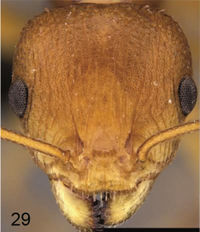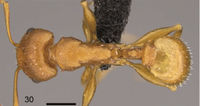Nesomyrmex spinosus
| Nesomyrmex spinosus | |
|---|---|

| |
| Scientific classification | |
| Kingdom: | Animalia |
| Phylum: | Arthropoda |
| Class: | Insecta |
| Order: | Hymenoptera |
| Family: | Formicidae |
| Subfamily: | Myrmicinae |
| Tribe: | Crematogastrini |
| Genus: | Nesomyrmex |
| Species group: | hafahafa |
| Species: | N. spinosus |
| Binomial name | |
| Nesomyrmex spinosus Csösz & Fisher, 2015 | |
This species is known to occur in small, highly isolated forests (Réserve Privé Berenty, Forêt d’Anjapolo and Parc National d’Andohahela, Forêt d’Ambohibory) in the southern part of Madagascar.
Identification
A member of the hafahafa species-group. The three pairs of dorsal spines (pronotal spines, propodeal spines and antero-dorsal spines on petiolar node) makes the appearance of this group extremely unique; no similar species group has been found either in the Malagasy region or on the African continent.
Keys including this Species
Distribution
Latitudinal Distribution Pattern
Latitudinal Range: -24.93° to -25.021°.
| North Temperate |
North Subtropical |
Tropical | South Subtropical |
South Temperate |
- Source: AntMaps
Distribution based on Regional Taxon Lists
Malagasy Region: Madagascar (type locality).
Distribution based on AntMaps
Distribution based on AntWeb specimens
Check data from AntWeb
Countries Occupied
| Number of countries occupied by this species based on AntWiki Regional Taxon Lists. In general, fewer countries occupied indicates a narrower range, while more countries indicates a more widespread species. |

|
Estimated Abundance
| Relative abundance based on number of AntMaps records per species (this species within the purple bar). Fewer records (to the left) indicates a less abundant/encountered species while more records (to the right) indicates more abundant/encountered species. |

|
Biology
Castes
Nomenclature
The following information is derived from Barry Bolton's Online Catalogue of the Ants of the World.
- spinosus. Nesomyrmex spinosus Csösz & Fisher, 2015: 53, figs. 28-30 (w.m.) MADAGASCAR.
Unless otherwise noted the text for the remainder of this section is reported from the publication that includes the original description.
Description
Worker
Body color: brown. Body color pattern: body concolorous, only clava darker. Absolute cephalic size: 1021 [935, 1121] μm (n=46). Cephalic length vs. maximum width of head capsule (CL/CWb): 1.056 [0.980, 1.113]. Postocular distance vs. cephalic length (PoOc/CL): 0.374 [0.342, 0.393]. Postocular sides of cranium contour frontal view orientation: converging posteriorly. Postocular sides of cranium contour frontal view shape: broadly convex. Vertex contour line in frontal view shape: slightly concave. Vertex sculpture: main sculpture rugose, ground sculpture areolate. Gena contour line in frontal view shape: feebly convex. Genae contour from anterior view orientation: converging. Gena sculpture: rugo-reticulate with areolate ground sculpture. Concentric carinae laterally surrounding antennal foramen count: present. Eye length vs. absolute cephalic size (EL/CS): 0.239 [0.220, 0.265]. Frontal carina distance vs. absolute cephalic size (FRS/CS): 0.315 [0.291, 0.335]. Longitudinal carinae on median region of frons count: present. Longitudinal carinae on medial region of frons shape: forked. Smooth median region on frons count: absent. Antennomere count: 12. Scape length vs. absolute cephalic size (SL/ CS): 0.880 [0.844, 0.919]. Facial area of the scape absolute setal angle: setae absent, pubescence only. Median clypeal notch count: present. Median clypeal notch depth vs. absolute cephalic size (Cdep/CS): 0.021 [0.015, 0.027]. Ground sculpture of submedian area of clypeus: smooth. Median carina of clypeus count: present. Lateral carinae of clypeus count: present. Median anatomical line of propodeal spine angle value to Weber length in lateral view: 65°. Spine length vs. absolute cephalic size (SPST/CS): 0.300 [0.258, 0.330]. Minimum spine distance vs. absolute cephalic size (SPBA/CS): 0.212 [0.184, 0.235]. Apical spine distance vs. absolute cephalic size (SPTI/CS): 0.307 [0.221, 0.361]. Propodeal spine shape: straight; slightly bent. Apical distance of pronotal spines vs. absolute cephalic size (PSTI/CS): 0.677 [0.624, 0.723]. Metanotal depression count: absent. Dorsal region of mesosoma sculpture: rugose with areolate ground sculpture. Lateral region of pronotum sculpture: areolate ground sculpture, superimposed by dispersed rugae. Mesopleuron sculpture: areolate ground sculpture, superimposed by dispersed rugae. Metapleuron sculpture: areolate ground sculpture, superimposed by dispersed rugae. Petiole width vs. absolute cephalic size (PEW/CS): 0.237 [0.206, 0.259]. Anterodorsal spines on petiolar node angle of deviation from each other: 60°. Apical distance of anterodorsal spines on petiolar node vs. absolute cephalic size (NSTI/CS): 0.216 [0.194, 0.276]. Frontal profile of petiolar node contour line in lateral view shape: straight. Dorso-caudal petiolar profile contour line in lateral view shape: convex. Dorsal region of petiole sculpture: ground sculpture areolate, main sculpture absent; ground sculpture areolate, main sculpture dispersed rugose. Postpetiole width vs. absolute cephalic size (PPW/CS): 0.491 [0.435, 0.529]. Dorsal region of postpetiole sculpture: ground sculpture areolate, main sculpture absent; ground sculpture areolate, main sculpture dispersed rugose.
Type Material
Holotype worker. CASENT0443515, BLF05489; MADGAGASCAR: Prov. Toliara, Réserve Privé Berenty, Forêt d’Anjapolo, 21.4 km 325° NW Amboasary, 24°56'S, 46°13'E [-24.92972 N, 46.20967 E], 65 m, 7.iii.2002 Fisher et al. (California Academy of Sciences CASENT0443515); Paratypes. 24 workers and three males with the same label data with the holotype (CAS).
Etymology
Name “spinosus” refers to the short, strong antero-dorsal spines on the petiolar node.
References
References based on Global Ant Biodiversity Informatics
- Csosz S., and B. L. Fisher. 2015. Diagnostic survey of Malagasy Nesomyrmex species-groups and revision of hafahafa group species via morphology based cluster delimitation protocol. ZooKeys 526: 19–59.

